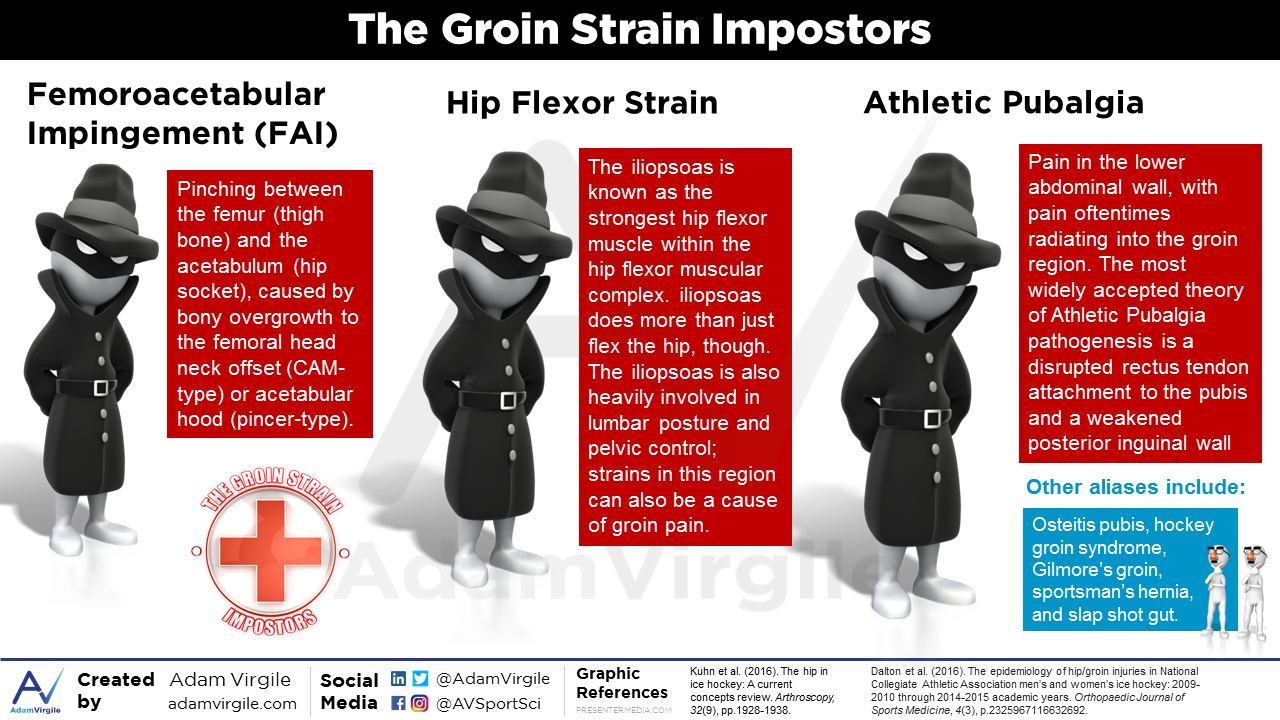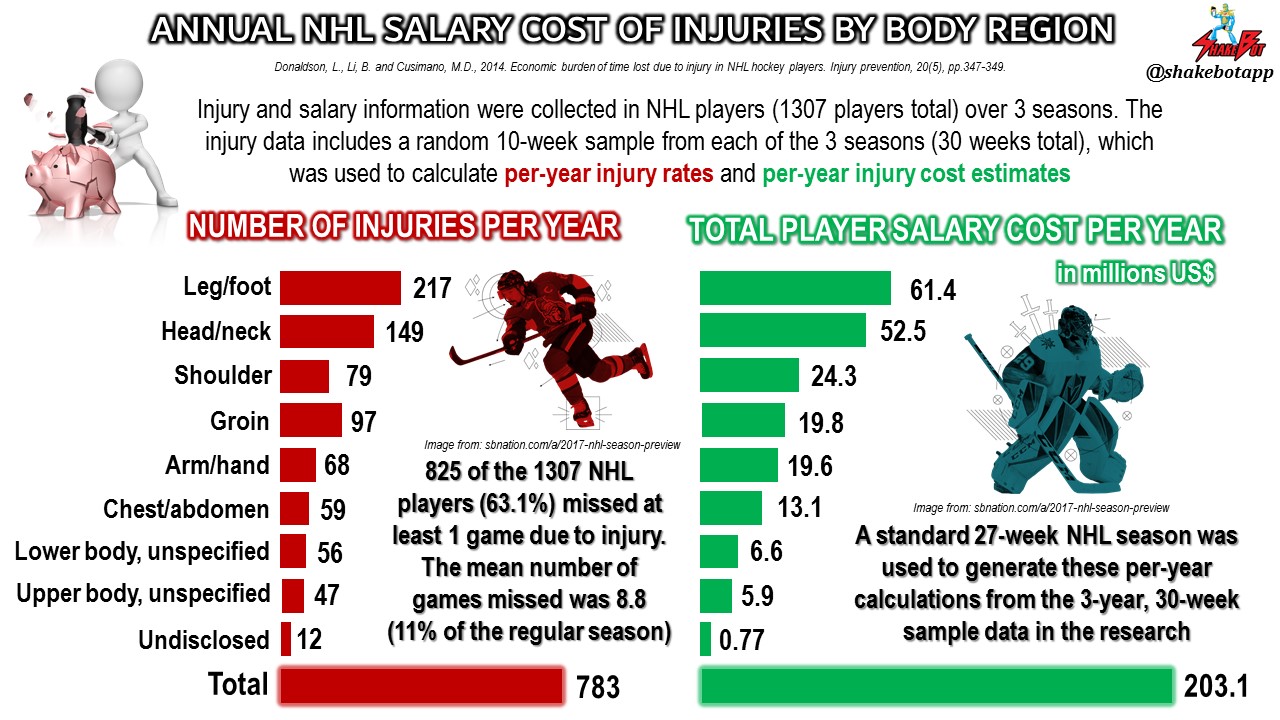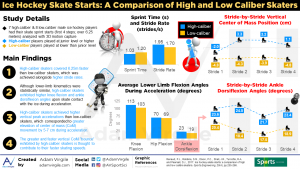There are many core and hip-related injuries that cause groin pain in ice hockey athletes. Although the groin pain is real, a groin strain may not be the primary cause. Here are a few hip pathologies that oftentimes result in groin pain.
Groin Strain Impostor 1: Femoroacetabular Impingement (FAI)
Although it is an intra-articular hip injury, femoroacetabular impingement (FAI) is the most commonly diagnosed cause of hip and groin pain in ice hockey players at all ages and levels of play [1-3]. FAI has become an increasingly common diagnosis in ice hockey players but is difficult to differentiate from strains because its pathophysiology is poorly understood [4]. FAI refers to pinching between the femur (thigh bone) and the acetabulum (hip socket), caused by bony overgrowth to the femoral head neck offset (CAM-type) or acetabular hood (pincer-type), but the body responds to FAI with inflammation and tightening of the hip capsule, causing compensatory strain to muscles around the hip. FAI is generally associated with hip pain and functional impairments such as limited ROM [5-8], hip muscle weakness [9-11], and compromised athletic performance [3, 11]. Although pincer-type FAI is relevant, CAM-type FAI is the far more common variation that occurs in young athletic males, and is the most commonly diagnosed type in ice hockey players [1, 2, 12-14]. It has been reported that the risk of a CAM-type FAI is ~15x higher in elite male ice hockey players compared with their age-matched counterparts [14], and is 4.5 times higher in ice hockey players 16-19 years old compared with age-matched skiers [13]. In a study of 130 NHL and AHL players during the 2014-15 preseason, 69.4% of hips met radiographic criteria for CAM-type deformity, with 61% of players presenting with CAM-type deformity bilaterally [8].
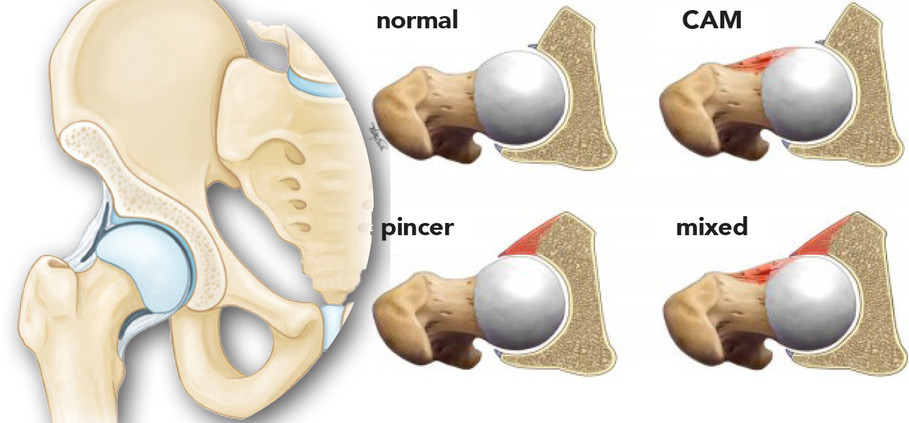
As discussed in Part 1 of this article series, the unique locomotion required in skating is likely a heavy contributor to the array of hip-related overuse injuries. In case you missed Part 2, you can it here. There’s no need to read them now, but when you’re done reading this, I’d strongly advise checking them out!
High physical stresses passing through the hip in skating propulsion such as (1) explosive concentric hip abduction combined with external rotation and stride recovery and (2) eccentric and stabilizing hip flexion combined with adduction and internal rotation may partially explain the relatively high prevalence of FAI and hip strains in ice hockey players [13-19]. Although a paucity of research currently exists in elite ice hockey players, FAI is typically associated with hip muscle weakness [20-22], particularly in the primary stabilizers and eccentric contributors to the ice hockey stride, the hip flexors and adductors [9, 11]. Also, labral tears comprise the majority of intra-articular hip injuries (69.1%) in NHL players [23], and these tears are oftentimes the result of underlying FAI [24]. Diagnosing and addressing FAI, or any source of hip pain at an early stage, may reduce compensatory strategies and prevent subsequent performance decrements and/or injury. Research is limited in ice hockey, but data from other sports imply that continuing to train and play with groin pain has been shown to result in movement compensation strategies, resulting in decreased function and performance [25-30].
Groin Strain Impostor 2: Athletic Pubalgia
Core muscle injuries are common in ice hockey; over the course of two seasons in the NHL, abdominal strains were found to account for 23.2% of all groin-related strains [31, 32]. Athletic Pubalgia is a core muscle injury, and is a common cause of chronic groin pain in athletes [33]. The injury is categorized by pain in the lower abdominal wall, with pain oftentimes radiating into the groin region [31, 34]. Because of this, it’s labeled as a “core muscle injury,” although there are at least 33 different terms which are used to describe it [35]. Other terms used to describe Athletic Pubalgia include osteitis pubis, hockey groin syndrome, Gilmore’s groin, sportsman’s hernia, and slap shot gut [31, 35].
It’s clear that the abdominal muscles are heavily used and play important roles in successful ice hockey performance. One study on 10 professional ice hockey players found consistent and distinct thinning/tearing in the internal oblique at the inguinal ring [36]. Another group of researchers found extensive tearing of external oblique muscles on the side opposite of the athletes’ shooting side [37]. The authors suggested that this result was caused by the specific biomechanical demands of hockey (i.e. skating, shooting, passing) and other intrinsic factors including muscle fatigue, weak abdominal muscles, and overtraining [37]. It’s easy to see how the constant application of forces by the abdominal wall muscles during twisting, turning and shooting maneuvers may cause tensioning and cordlike bands within the inguinal ligament over time [38]. The forces of the abdominals are transmitted through the inguinal ligament onto the pubic tubercle during ice hockey [38]. The associated groin pain with Athletic Pubalgia becomes apparent when the heavy contribution and force transmission of the abdominal musculature in ice hockey is examined, holistically.

The most widely accepted theory of Athletic Pubalgia pathogenesis is a disrupted rectus tendon attachment to the pubis and a weakened posterior inguinal wall [39-46]. Given this pathogenesis, it’s no surprise that athletes with adductor and pubic-related groin pain oftentimes present with reduced abdominal muscle strength [29, 47]. The balance in muscle strength between the hips and abdominals may play a pivotal role in preventing Athletic Pubalgia. It has been suggested that weakness of the lower abdominal muscles relative to the hip adductors can be a primary cause [48]. In fact, it’s suggested that treatment for Athletic Pubalgia should include restoring the balance between the forces applied by the abdominal and hip adductor muscle groups [34, 49, 50].
Groin Strain Impostor 3: Hip Flexor Strain
In NCAA Men’s Ice Hockey, hip flexor strains were just as frequent as groin strains, as both injuries boast a whopping frequency of 2.47 injuries per 1000 athlete exposures [51]. Hip flexor and groin strains are extremely common in ice hockey; of all NCAA Men’s Sports, soccer was the only sport to have higher injury rates for hip flexor and groin strains [51].
The iliopsoas is the strongest hip flexor muscle within the hip flexor muscular complex [52] and is comprised of the psoas major, psoas minor, and iliacus muscles [53]. Although considered the primary hip flexor muscle, the iliopsoas does much more than just flex the hip. The iliopsoas is also heavily involved in lumbar posture and pelvic control; strains in this region can also be a cause of groin pain in the ice hockey player [31, 32, 54]. A group of researchers agreed that iliopsoas-related groin pain is more likely if there is pain on resisted hip flexion and/or pain on stretching the hip flexors, which illustrates the close relationship between the groin and hip flexion musculature [55].

The contribution of the hip flexors in ice hockey cannot be overstated. Hip flexion is greater during on-ice sprinting in high-caliber skaters, compared with low-caliber players [56-58]. During hockey treadmill skating, increased treadmill velocity was associated with increased hip flexor activation [59]. Back in 1977, Reid et al. found a relationship between off-ice hip flexion strength and on-ice skating speed in varsity ice hockey players [60]. These results hint that the biomechanical demands of the hip flexor muscles are increased alongside higher level of play and increased speed requirements, on-ice [31]. The multifaceted functionality of the hip flexor muscles in addition to the heavy reliance on these muscles for successful on-ice performance illustrate the frequent association between hip flexor strain and groin pain in ice hockey athletes.
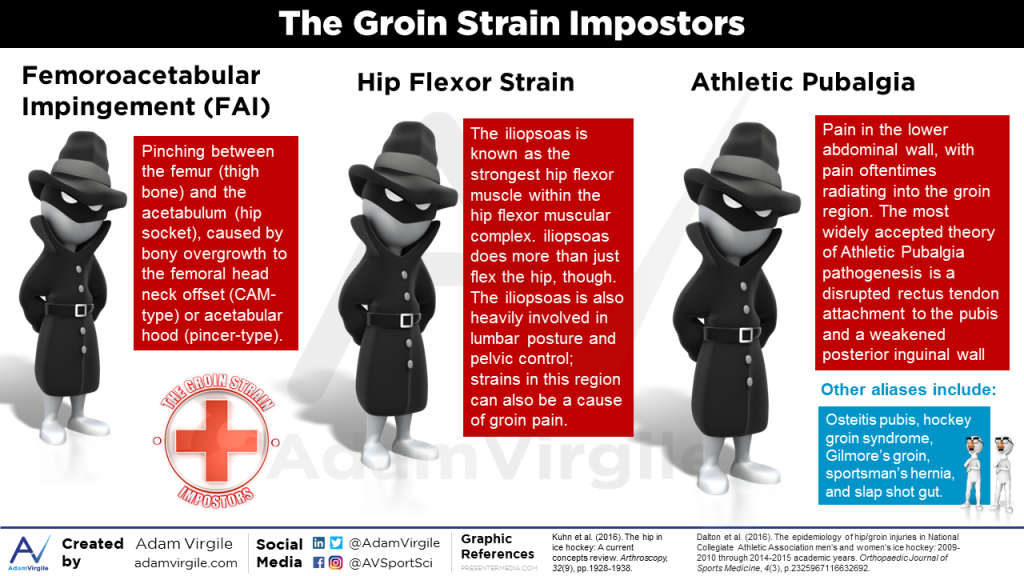
Summary
Groin pain in ice hockey athletes may not be from a groin strain. Understanding the pathology of the groin pain should play a major role in injury treatment, prevention of injury recurrence, and the strength and conditioning program. There are other pathologies that result in groin pain, including femoroacetabular impingement (FAI), athletic pubalgia, or a hip flexor strain. Watch out for these groin strain impostors when evaluating an ice hockey athlete presenting with groin pain.
For a brief overview of the importance of the hip in ice hockey, go here.
To see how susceptible the hip is to injury and the risk factors for groin strains, go here.
To see the costs (financial and other) of injury, including hip injury, go here.
To see how to develop a hip screening and monitoring protocol, go here.
To see how to treat different types of hip pain, go here.
To see how early ice hockey specialization (i.e. year-round participation) can negatively impact the hips, go here.
Reference
- Stull, J.D., Philippon, M.J. and LaPrade, R.F., 2011. “At-risk” positioning and hip biomechanics of the Peewee ice hockey sprint start. The American journal of sports medicine, 39(1_suppl), pp.29-35.
- Ayeni, O.R., Kowalczuk, M., Farag, J., Farrokhyar, F., Chu, R., Bedi, A., Willits, K. and Bhandari, M., 2014. Trends in reporting of mechanisms and incidence of hip injuries in males playing minor ice hockey in Canada: a cross-sectional study. Open access journal of sports medicine, 5, p.143.
- Shindle, M.K., Marx, R.G., Kelly, B.T., Bisson, L. and Burke III, C.J., 2010. Hockey injuries: a pediatric sport update. ?Current opinion in pediatrics?, ?22?(1), pp.54-60.
- Dalton, S.L., Zupon, A.B., Gardner, E.C., Djoko, A., Dompier, T.P. and Kerr, Z.Y., 2016. The epidemiology of hip/groin injuries in national collegiate athletic association men’s and women’s ice hockey: 2009-2010 through 2014-2015 academic years. Orthopaedic journal of sports medicine, 4(3), p.2325967116632692.
- Nötzli, H.P., Wyss, T.F., Stoecklin, C.H., Schmid, M.R., Treiber, K. and Hodler, J., 2002. The contour of the femoral head-neck junction as a predictor for the risk of anterior impingement. ?Bone & Joint Journal?, ?84?(4), pp.556-560.
- Casartelli, N.C., Maffiuletti, N.A., Leunig, M. and Bizzini, M., 2015. Femoroacetabular impingement in sports medicine: a narrative review. ?Schweizerische Zeitschrift für Sportmedizin & Sporttraumatologie?, 63?(2).
- Yuan, B.J., Bartelt, R.B., Levy, B.A., Bond, J.R., Trousdale, R.T. and Sierra, R.J., 2013. Decreased range of motion is associated with structural hip deformity in asymptomatic adolescent athletes. The American journal of sports medicine?, ?41?(7), pp.1519-1525.
- Lerebours, F., Robertson, W., Neri, B., Schulz, B., Youm, T. and Limpisvasti, O., 2016. Prevalence of cam-type morphology in elite ice hockey players. ?The American journal of sports medicine?, ?44?(4), pp.1024-1030.
- Casartelli, N.C., Leunig, M., Maffiuletti, N.A. and Bizzini, M., 2015. Return to sport after hip surgery for femoroacetabular impingement: a systematic review. ?Br J Sports Med, pp.bjsports-2014.
- ?Brunner, R., Maffiuletti, N.A., Casartelli, N.C., Bizzini, M., Sutter, R., Pfirrmann, C.W. and Leunig, M., 2016. Prevalence and functional consequences of femoroacetabular impingement in young male ice hockey players. ?The American journal of sports medicine, 44(1), pp.46-53.
- Casartelli, N.C., Maffiuletti, N.A., Item-Glatthorn, J.F., Staehli, S., Bizzini, M., Impellizzeri, F.M. and Leunig, M., 2011. Hip muscle weakness in patients with symptomatic femoroacetabular impingement. Osteoarthritis and cartilage, ?19?(7), pp.816-821.
- Pierce, C.M., LaPrade, R.F., Wahoff, M., O’brien, L. and Philippon, M.J., 2013. Ice hockey goaltender rehabilitation, including on-ice progression, after arthroscopic hip surgery for femoroacetabular impingement. ?journal of orthopaedic & sports physical therapy?, ?43?(3), pp.129-141.
- ?Philippon, M.J., Ho, C.P., Briggs, K.K., Stull, J. and LaPrade, R.F., 2013. Prevalence of increased alpha angles as a measure of cam-type femoroacetabular impingement in youth ice hockey players. ?The American journal of sports medicine?, ?41?(6), pp.1357-1362.
- Siebenrock, K.A., Kaschka, I., Frauchiger, L., Werlen, S. and Schwab, J.M., 2013. Prevalence of cam-type deformity and hip pain in elite ice hockey players before and after the end of growth. ?The American journal of sports medicine?, ?41?(10), pp.2308-2313.
- Tyler, T.F., Nicholas, S.J., Campbell, R.J. and McHugh, M.P., 2001. The association of hip strength and flexibility with the incidence of adductor muscle strains in professional ice hockey players. The American journal of sports medicine, 29(2), pp.124-128.
- Bracko, M.R., 2004. Biomechanics powers ice hockey performance. Biomechanics, 2004, pp.47-53.
- Marino, G.W., 1983. Selected mechanical factors associated with acceleration in ice skating. Research quarterly for exercise and sport, 54(3), pp.234-238.
- Renaud, P.J., Robbins, S.M., Dixon, P.C., Shell, J.R., Turcotte, R.A. and Pearsall, D.J., 2017. Ice hockey skate starts: a comparison of high and low calibre skaters. Sports Engineering, 20(4), pp.255-266.
- Chang, R., Turcotte, R. and Pearsall, D., 2009. Hip adductor muscle function in forward skating. Sports Biomechanics, 8(3), pp.212-222.
- Nepple, J.J., Goljan, P., Briggs, K.K., Garvey, S.E., Ryan, M. and Philippon, M.J., 2015. Hip strength deficits in patients with symptomatic femoroacetabular impingement and labral tears.Arthroscopy,? 31?(11),? pp.2106-2111.
- ?Freke, M.D., Kemp, J., Svege, I., Risberg, M.A., Semciw, A. and Crossley, K.M., 2016. Physical impairments in symptomatic femoroacetabular impingement: a systematic review of the evidence. ?Br J Sports Med?, pp.bjsports-2016.
- Mayne, E., Memarzadeh, A., Raut, P., Arora, A. and Khanduja, V., 2017. Measuring hip muscle strength in patients with femoroacetabular impingement and other hip pathologies: A systematic review. ?Bone and Joint Research?, ?6?(1), pp.66-72.
- Gallo, R.A., Silvis, M.L., Smetana, B., Stuck, D., Lynch, S.A., Mosher, T.J. and Black, K.P., 2014. Asymptomatic hip/groin pathology identified on magnetic resonance imaging of professional hockey players: Outcomes and playing status at 4 years’ follow-up. ?Arthroscopy?, ?30?(10), pp.1222-1228.
- Silvis, M.L., Mosher, T.J., Smetana, B.S., Chinchilli, V.M., Flemming, D.J., Walker, E.A. and Black, K.P., 2011. High prevalence of pelvic and hip magnetic resonance imaging findings in asymptomatic collegiate and professional hockey players. ?The American journal of sports medicine?, 39?(4), pp.715-721.
- ?Edwards, S., Brooke, H.C. and Cook, J.L., 2017. Distinct cut task strategy in Australian football players with a history of groin pain. ?Physical Therapy in Sport?, ?23?, pp.58-66.
- ?Franklyn-Miller, A., Richter, C., King, E., Gore, S., Moran, K., Strike, S. and Falvey, E.C., 2017. Athletic groin pain (part 2): a prospective cohort study on the biomechanical evaluation of change of direction identifies three clusters of movement patterns. ?Br J Sports Med?, ?51?(5), pp.460-468.
- ?van Rensburg, L.J., Dare, M., Louw, Q., Crous, L., Cockroft, J., Williams, L. and Olivier, B., 2017. Pelvic and hip kinematics during single-leg drop-landing are altered in sports participants with long-standing groin pain: A cross-sectional study. ?Physical Therapy in Sport?, ?26?, pp.20-26.
- ?Morrissey, D., Graham, J., Screen, H., Sinha, A., Small, C., Twycross-Lewis, R. and Woledge, R., 2012. Coronal plane hip muscle activation in football code athletes with chronic adductor groin strain injury during standing hip flexion. ?Manual therapy?, ?17?(2), pp.145-149.
- ?Mosler, A.B., Weir, A., Hölmich, P. and Crossley, K.M., 2015. Which factors differentiate athletes with hip/groin pain from those without? A systematic review with meta-analysis. ?Br J Sports Med?, ?49?(12), pp.810-810.
- ?Thorborg, K., Branci, S., Nielsen, M.P., Tang, L., Nielsen, M.B. and Hölmich, P., 2014. Eccentric and isometric hip adduction strength in male soccer players with and without adductor-related groin pain: an assessor-blinded comparison. ?Orthopaedic journal of sports medicine?, ?2?(2), p.2325967114521778.
- Kuhn, A.W., Noonan, B.C., Kelly, B.T., Larson, C.M. and Bedi, A., 2016. The hip in ice hockey: A current concepts review. Arthroscopy, 32(9), pp.1928-1938.
- Emery, C.A., Meeuwisse, W.H. and Powell, J.W., 1999. Groin and abdominal strain injuries in the National Hockey League. ?Clinical journal of sport medicine: official journal of the Canadian Academy of Sport Medicine?, ?9?(3), pp.151-156.
- Tyler, T.F., Silvers, H.J., Gerhardt, M.B. and Nicholas, S.J., 2010. Groin injuries in sports medicine. ?Sports health?, ?2?(3), pp.231-236.
- Arner, J.W., Disantis, A., Bradley, J.P., Zuckerbraun, B.S. and Mauro, C.S., 2017. Management of hip and groin pain in American football players. Annals of Joint, 2(12).
- ?Serner, A., van Eijck, C.H., Beumer, B.R., Hölmich, P., Weir, A. and de Vos, R.J., 2015. Study quality on groin injury management remains low: a systematic review on treatment of groin pain in athletes. ?Br J Sports Med?, pp.bjsports-2014.
- Simonet, W.T., Savior III, H.L. and Sim, L., 1995. Abdominal wall muscle tears in hockey players. ?International journal of sports medicine?, ?16?(02), pp.126-128.
- Lacroix, V.J., Kinnear, D.G., Mulder, D.S. and Brown, R.A., 1998. Lower abdominal pain syndrome in national hockey league players: a report of 11 cases. ?Clinical journal of sport medicine: official journal of the Canadian Academy of Sport Medicine?, ?8?(1), pp.5-9.
- Rennie, W.J. and Lloyd, D.M., 2017. Sportsmans Groin: The Inguinal Ligament and the Lloyd Technique. ?Journal of the Belgian Society of Radiology?, ?101?(S2).
- ?Ahumada, L.A., Ashruf, S., Espinosa-de-los-Monteros, A., Long, J.N., Jorge, I., Garth, W.P. and Vasconez, L.O., 2005. Athletic pubalgia: definition and surgical treatment. ?Annals of plastic surgery?, ?55?(4), pp.393-396.
- ?Genitsaris, M., Goulimaris, I. and Sikas, N., 2004. Laparoscopic repair of groin pain in athletes. ?The American journal of sports medicine?, ?32?(5), pp.1238-1242.
- ?Hackney, R.G., 1993. The sports hernia: a cause of chronic groin pain. ?British journal of sports medicine?, ?27?(1), pp.58-62.
- ?Elattar, O., Choi, H.R., Dills, V.D. and Busconi, B., 2016. Groin injuries (Athletic Pubalgia) and return to play. ?Sports health?, ?8?(4), pp.313-323.
- ?Kluin, J., den Hoed, P.T., van Linschoten, R., Ijzerman, J.C. and van Steensel, C.J., 2004. Endoscopic evaluation and treatment of groin pain in the athlete. ?The American journal of sports medicine?, ?32?(4), pp.944-949.
- ?Srinivasan, A. and Schuricht, A., 2002. Long-term follow-up of laparoscopic preperitoneal hernia repair in professional athletes. ?Journal of Laparoendoscopic & Advanced Surgical Techniques?, ?12?(2), pp.101-106.
- ?Steele, P., Annear, P. and Grove, J.R., 2004. Surgery for posterior inguinal wall deficiency in athletes. ?Journal of science and medicine in sport?, ?7?(4), pp.415-421.
- ?Susmallian, S., Ezri, T., Elis, M., Warters, R., Charuzi, I. and Muggia-Sullam, M., 2004. Laparoscopic repair of ‘sportsman’s hernia’in soccer players as treatment of chronic inguinal pain. Medical Science Monitor,? 10?(2),? pp.CR52-CR54.
- Kloskowska, P., Morrissey, D., Small, C., Malliaras, P. and Barton, C., 2016. Movement patterns and muscular function Before and after onset of sports-related groin pain: a systematic review with meta-analysis. ?Sports Medicine?, ?46?(12), pp.1847-1867.
- ?Anderson, K., Strickland, S.M. and Warren, R., 2001. Hip and groin injuries in athletes. The American journal of sports medicine,? 29?(4),? pp.521-533.
- Poor, A.E., Roedl, J.B., Zoga, A.C. and Meyers, W.C., 2018. Core muscle injuries in athletes. ?Current sports medicine reports?, ?17?(2), pp.54-58.
- Sheen, A.J. and Weir, A., 2017. Groin Pain in Athletes. In Textbook of Hernia (pp. 163-168). Springer, Cham.
- Eckard, T.G., Padua, D.A., Dompier, T.P., Dalton, S.L., Thorborg, K. and Kerr, Z.Y., 2017. Epidemiology of hip flexor and hip adductor strains in National Collegiate Athletic Association athletes, 2009/2010-2014/2015. The American journal of sports medicine, 45(12), pp.2713-2722.
- Robbins, C.E., 1998. Anatomy and biomechanics. The Hip Handbook. Boston, MA: Butterworth-Heinemann, pp.1-37.
- Hughes, P.E., Hsu, J.C. and Matava, M.J., 2002. Hip anatomy and biomechanics in the athlete. Sports medicine and arthroscopy review, 10(2), pp.103-114.
- Andersson, E., Oddsson, L., Grundström, H. and Thorstensson, A., 1995. The role of the psoas and iliacus muscles for stability and movement of the lumbar spine, pelvis and hip. Scandinavian journal of medicine & science in sports?, ?5?(1), pp.10-16.
- Weir, A., Brukner, P., Delahunt, E., Ekstrand, J., Griffin, D., Khan, K.M., Lovell, G., Meyers, W.C., Muschaweck, U., Orchard, J. and Paajanen, H., 2015. Doha agreement meeting on terminology and definitions in groin pain in athletes. Br J Sports Med, 49(12), pp.768-774.
- Upjohn, T., Turcotte, R., Pearsall, D.J. and Loh, J., 2008. Three-dimensional kinematics of the lower limbs during forward ice hockey skating. Sports biomechanics, 7(2), pp.206-221.
- McCaw, S.T. and Hoshizaki, T.B., 1987. A kinematic comparison of novice, intermediate, and elite ice skaters. Biomechanics XB, pp.637-642.
- Buckeridge, E., LeVangie, M.C., Stetter, B., Nigg, S.R. and Nigg, B.M., 2015. An on-ice measurement approach to analyse the biomechanics of ice hockey skating. ?PloS one?, ?10?(5), p.e0127324.
- Goudreault, R., 2003. Forward skating in ice hockey: Comparison of EMG activation patterns at three velocities using a skate treadmill.
- Reid, R.W., 1977. Relationship of lower limb flexibility, strength, and anthropometric measures to skating speed in varsity hockey players/by Randall W. Reid.–.

